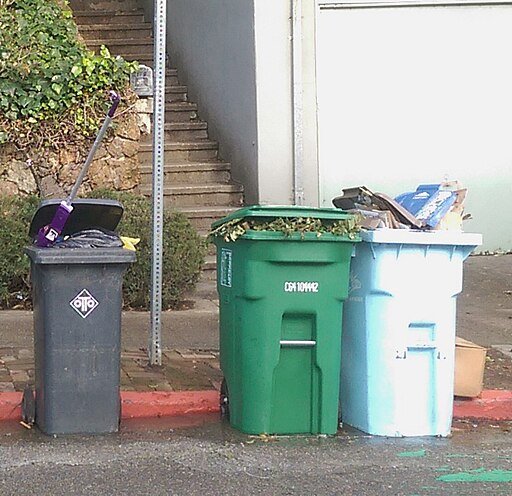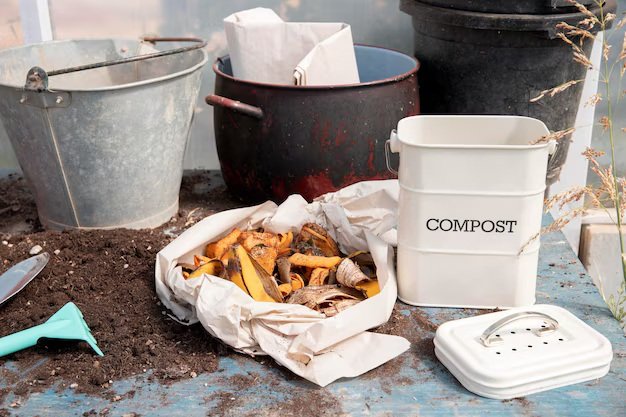Why Curbside Composting Matters — and Why Cities are Pushing It Now
Compost might sound like a backyard hobby, but when cities collect food scraps at the curb, it becomes a climate and public-health tool. Food and other organic materials are a large share of what we throw away; when they rot in landfills, they produce methane, a greenhouse gas far more powerful than carbon dioxide. According to the U.S. Environmental Protection Agency, food makes up roughly 24% of municipal solid waste, and wasted food is responsible for a large share of landfill methane emissions. Composting those scraps instead turns them into a soil product that stores carbon, improves soil health and helps farms and gardens hold more water.
The numbers behind the idea are striking. A national survey of municipal programs found sharp growth in access to food-scrap collection: 14.9 million households in the United States had curbside or drop-off food-waste collection in 2023, up nearly 50% from 2021. That expansion matters because access is the first barrier — you can’t compost at scale unless the service exists and is easy to use. According to BioCycle’s 2023 survey, the growth in programs has been driven in part by state laws and large city rollouts that made collection a standard municipal service rather than an optional add-on.

How Cities are Doing It — Programs and Results
Cities use different models: mandatory programs, automatic “standard offering” collection, opt-in systems, and combinations with drop-off sites. New York City’s recent rollout is the clearest large-scale example: Mayor Eric Adams announced the citywide, no-cost curbside organics collection program in October 2024 and framed it as a step to divert hundreds of millions of pounds of organic waste from landfills each year. City officials say the program moves material into composting and renewable-energy facilities and will help reduce food-based emissions by a planned 33% by 2030. According to the Mayor’s office, the program showed a 65% jump in material diverted over two years in its early reports.
San Francisco is often held up as the model most cities study. The city’s green-bin program dates back decades, and the city reports collecting hundreds of tons of organics per day; the program has been credited with helping San Francisco reach high overall diversion rates and providing finished compost to local farms and landscapers. City leaders there point to the program’s long public-education effort and legal requirements as reasons for its staying power. According to San Francisco’s Environment Department, the program began as a pilot in the 1990s and scaled to mandatory participation, now hauling more than 500 tons per day into compost facilities and diverting millions of tons since the program began.
What People on the Ground Say — Successes, Friction, and Lessons
Real people make these programs work — and they’re also the ones who point out what needs fixing. City officials and environmental leaders often highlight the climate and public-health benefits. In San Francisco, Mayor London Breed and local environmental directors have praised residents for changing their habits and noted composting’s benefits for soil health and carbon sequestration. Leaders argue that the program’s longevity reflects consistent outreach and a willingness to adapt operations.
But rollout friction is real. New Yorker reporting and local coverage of big city efforts show staff and residents wrestling with logistics, storage space in small apartments, heat-season odours, missed collections, and enforcement questions. Some sanitation and community-composting groups have also pushed back when municipal programs scaled up in ways that changed how small community composters operated. Those tensions are part of why officials stress outreach and contractor performance measures. According to reporting in The New Yorker, one high-level sanitation leader framed the overhaul as a “Trash Revolution” in which containerization, weekly organics pickup and stronger enforcement were all part of the same push — and community groups warned against cutting support for grassroots compost programs.
There are also powerful, local success stories that show different models can work. In East London, an urban project called City Soil Lab turns restaurant scraps into nutrient-rich compost using fermentation techniques and small-scale anaerobic systems; the founder says this approach lets him handle materials—like bones and dairy—that traditional community composting often excludes. That project is now being piloted with local council support to see whether its methods can be scaled to feed nearby gardens and improve urban soils. According to The Guardian, the City Soil Lab turned a shuttered restaurant space into a communal compost system with direct benefits for local food production.
Experts point to a few recurring lessons. Program design matters: opt-in systems generally require more outreach to reach broad participation; mandatory or automatic offerings get higher coverage but need enforcement and good labelling to avoid contamination; and contractor or haulier performance (weekly collection, responsive education) is vital to prevent problems like odours and pests. A national analysis in BioCycle stresses that program outcomes vary a lot depending on whether collection is opt-in, standard, or mandatory and how contamination is handled.
How Curbside Composting Actually Works for a Household — Simple, Practical Advice
If your city offers curbside composting, you can make it painless for yourself and effective for the program. First, learn the rules your city posts about what’s accepted (food scraps, soiled paper, yard waste, bones and dairy are sometimes treated differently depending on the facility). According to municipal guidance and EPA resources, many municipal programs accept most food and soiled paper, but local rules can restrict compostable packaging or require paper liners — check your city website before you buy speciality bags.
Second, manage the “yuck factor.” Store scraps in a small lidded kitchen pail, use paper towels or a newspaper layer, or keep your pouch in the fridge or freezer between pickups — many residents report this is the single change that makes weekly set-outs bearable. If you worry about pests or summer heat, line the bin with paper or a certified compostable liner if allowed; the BioCycle survey notes that the inability to use liner bags can reduce participation in some programs, especially where food waste is mixed with yard trimmings.
Third, be a contamination watchdog. Don’t put plastic bags, metal, or non-compostable packaging in the organics cart — contaminated loads can be rejected at the facility. When sanitary or odour problems occur, report missed collections and request education materials; cities that couple collection with strong outreach see better long-term results. According to city rollouts that included outreach and school programs, combining education with easy rules increases participation and reduces contamination.
Finally, get involved locally. Local community composters, school programs, and urban gardens can use finished compost directly. Projects like City Soil Lab show that small-scale innovation can complement municipal systems by handling special streams or supplying local green spaces. If your city is just starting a program, volunteer for outreach, ask your community board for better service times, or work with your building manager to provide labelled storage. Real-world pilots show that local champions accelerate adoption and fix practical barriers faster than top-down directives alone.
Conclusion
Cities are learning that curbside composting is not just about trucks and facilities; it’s about habits, clear rules, responsive collection, and the few people who act as local champions. The technology and the climate case are clear: diverting organics reduces methane, returns nutrients to soil, and produces useful compost. The human part — teaching, listening, and adapting collection systems to the realities of apartment living and hot summers — is the trickier half. If your city offers the service, try it, store scraps in a sealed pail, and sign up (or set the bin out) on collection day. If your city is still deciding, push for a program design that combines easy access, steady outreach, and local partnerships — the cities that succeed make composting the easiest thing you do with a banana peel. EPA+2BioCycle+2







